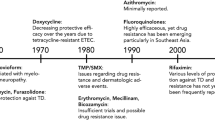Abstract
Travelers’ diarrhea affects more than 10 million people per year and is usually contracted through the ingestion of microbially contaminated food or water. Although most cases resolve in 3 to 5 days, chronic conditions are associated with acute infections. Prevention encompasses avoidance of ingesting contaminated products and, in certain situations, taking prophylactic medications. The available prophylactic antibiotics are very effective in prevention, but are recommended only for specific at-risk individuals and are contraindicated for most travelers.
Similar content being viewed by others
References and Recommended Reading
Steffen R: Epidemiologic studies of travelers’ diarrhea, severe gastrointestinal infections, and cholera, Rev Infect Dis 1986, 8(Suppl 2):S122–S130.
Rees JR, Pannier MA, McNees A, et al.: Persistent diarrhea, arthritis, and other complications of enteric infections: a pilot survey based on California FoodNet surveillance, 1998–1999. Clin Infect Dis 2004, 38(Suppl 3):S311–S317.
Sharp TW, Thornton SA, Wallace MR, et al.: Diarrheal disease among military personnel during Operation Restore Hope, Somalia, 1992–1993. Am J Trop Med Hyg 1995, 52:188–193.
Taylor DN, Rizzo J, Meza R, et al.: Cholera among Americans living in Peru. Clin Infect Dis 1996, 22:1108–1109.
von Sonnenburg F, Tornieporth N, Waiyaki P, et al.: Risk and aetiology of diarrhoea at various tourist destinations. Lancet 2000, 356:133–134.
Shlim DR: Update in travelers’ diarrhea. Infect Dis Clin North Am 2005, 19:137–149.
Widdowson M, Monroe SS, Glass RI: Are noroviruses emerging? Emerg Infect Dis 2005, 11:735–737.
Huang DB, Sanchez AP, Triana E, et al.: United States male students who heavily consume alcohol in Mexico are at greater risk of travelers’ diarrhea than their female counterparts. J Travel Med 2004, 11:143–145.
Kozicki M, Steffen R, Schär M: ’Boil it, cook it, peel it or forget it’: does this rule prevent travellers’ diarrhoea? Int J Epidemiol 1985, 14:169–172.
Hill DR, Ericsson CD, Pearson RD, et al.: The practice of travel medicine: guidelines by the Infectious Diseases Society of America. Clin Infect Dis 2006, 43:1499–1539.
Steffen R: Epidemiology of travelers’ diarrhea. Clin Infect Dis 2006, 41(Suppl 8):S536–S540.
Frech SA, Dupont HL, Bourgeois AL, et al.: Use of patch containing heat-labile toxin from Escherichia coli against travellers’ diarrhoea: a phase II, randomized, double-blind, placebo-controlled field trial. Lancet 2008, 371:2019.
DuPont HL, Sullivan P, Evans DG, et al.: Prevention of travelers’ diarrhea (emporiatric enteritis). Prophylactic administration of subsalicylate bismuth. JAMA 1980, 243:237–241.
Dupont HL, Ericsson CD, Johnson PC, et al.: Prevention of travelers’ diarrhea by the tablet formulation of bismuth subsalicylate. Antimicrob Agents Chemother 1986, 29:625–627.
Taylor DN, Sanchez JL, Candler W, et al.: Treatment of travelers’ diarrhea: ciprofloxacin plus loperamide compared with ciprofloxacin alone. A placebo-controlled, randomized trial. Ann Intern Med 1991, 114:731–734.
Sack RB, Santosham M, Froelich JL, et al.: Doxycyline prophylaxis of travelers’ diarrhea in Honduras, an area where resistance to doxycycline is common among enterotoxigenic Escherichia coli. Am J Trop Med Hyg 1984, 33:460–466.
Rademaker CMA, Hoepleman IM, Wolfhagen HM, et al.: Results of a double-blind placebo-controlled study using ciprofloxacin for prevention of travelers’ diarrhea. Eur J Clin Microbiol Infect Dis 1989, 8:690–694.
Dupont H, Jiang ZD, Okhuysen PC, et al.: A randomized, double-blind, placebo-controlled trial of azithromycin found to be comparable to levofloxacin for the treatment of US travelers with acute diarrhea acquired in Mexico. Clin Infect Dis 2003, 37:1165–1171.
DuPont HL, Jiang ZD, Okhuysen PC, et al.: A randomized, double-blind, placebo-controlled trial of rifaximin to prevent travelers’ diarrhea. Ann Intern Med 2005, 142:805–812.
McFarland LV: Meta-analysis of probiotics for the prevention of traveler’s diarrhea. Travel Med Infect Dis 2007, 5:97–105.
Author information
Authors and Affiliations
Corresponding author
Rights and permissions
About this article
Cite this article
Singh, E., Redfield, D. Prophylaxis for travelers’ diarrhea. Curr Gastroenterol Rep 11, 297–300 (2009). https://doi.org/10.1007/s11894-009-0043-1
Published:
Issue Date:
DOI: https://doi.org/10.1007/s11894-009-0043-1




